Capital punishment, also known as the death penalty and formerly called judicial homicide, is the state-sanctioned practice of killing a person as a punishment for a crime, usually following an authorised, rule-governed process to conclude that the person is responsible for violating norms that warrant said punishment. The sentence ordering that an offender be punished in such a manner is known as a death sentence, and the act of carrying out the sentence is known as an execution. A prisoner who has been sentenced to death and awaits execution is condemned and is commonly referred to as being "on death row". Etymologically, the term capital refers to execution by beheading, but executions are carried out by many methods, including hanging, shooting, lethal injection, stoning, electrocution, and gassing.
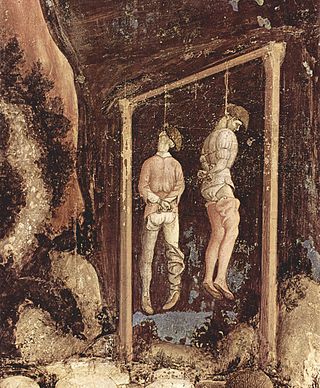
Hanging is killing a person by suspending them from the neck with a noose or ligature. Hanging has been a common method of capital punishment since the Middle Ages, and is the primary execution method in numerous countries and regions. The first known account of execution by hanging is in Homer's Odyssey. Hanging is also a method of suicide.

Capital punishment in the United Kingdom predates the formation of the UK, having been used within the British Isles from ancient times until the second half of the 20th century. The last executions in the United Kingdom were by hanging, and took place in 1964; capital punishment for murder was suspended in 1965 and finally abolished in 1969. Although unused, the death penalty remained a legally defined punishment for certain offences such as treason until it was completely abolished in 1998; the last execution for treason took place in 1946. In 2004 the 13th Protocol to the European Convention on Human Rights became binding on the United Kingdom; it prohibits the restoration of the death penalty as long as the UK is a party to the convention.

Capital punishment is a legal penalty in the U.S. state of Ohio, although all executions have been suspended indefinitely by Governor Mike DeWine until a replacement for lethal injection is chosen by the Ohio General Assembly. The last execution in the state was in July 2018, when Robert J. Van Hook was executed via lethal injection for murder.

Capital punishment was abolished via the legislative process on May 2, 2013, in the U.S. state of Maryland.
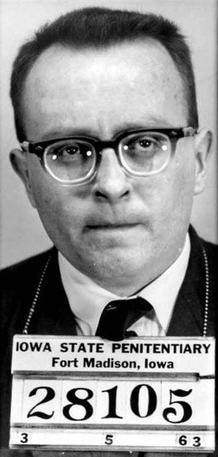
Victor Harry Feguer was a convicted murderer, and the last federal inmate executed in the United States before the moratorium on the death penalty following Furman v. Georgia, as well as the last person put to death in the state of Iowa. While the media did not pay much attention to Feguer or his execution at the time, Timothy McVeigh's execution sparked renewed media interest in him.
Capital punishment in Canada dates back to Canada's earliest history, including its period as a French colony and, after 1763, its time as a British colony. From 1867 to the elimination of the death penalty for murder on July 26, 1976, 1,481 people had been sentenced to death, and 710 had been executed. Of those executed, 697 were men and 13 were women. The only method used in Canada for capital punishment of civilians after the end of the French regime was hanging. The last execution in Canada was the double hanging of Arthur Lucas and Ronald Turpin on December 11, 1962, at Toronto's Don Jail. The military prescribed firing squad as the method of execution until 1999, although no military executions had been carried out since 1946.

Capital punishment in New Zealand – the process of sentencing convicted offenders to death for the most serious crimes and carrying out that sentence, as ordered by a legal system – first appeared in a codified form when New Zealand became a British colony in 1840. It was first carried out with a public hanging in Victoria Street, Auckland in 1842, while the last execution occurred in 1957 at Mount Eden Prison, also in Auckland. In total, 85 people have been executed in New Zealand.

The Don Jail was a jail in Toronto, Ontario, Canada, located to the east of the Don River, on Gerrard Street East in the Riverdale neighbourhood. The original building was completed in 1864 and was reopened in 2013 to serve as the administrative wing of Bridgepoint Active Healthcare, a rehabilitation hospital located adjacent to the jail. Prior to its adaptive reuse as part of a healthcare facility, the building was used as a provincial jail for remanded offenders and was officially known as the Toronto Jail. The jail originally had a capacity of 184 inmates, and it was separated into an east wing for the men and a west wing for the women.
Capital punishment is a legal penalty in Sri Lanka.
Capital punishment is a legal punishment in Iran. Crimes punishable by death include murder; rape; child molestation; homosexuality; pedophilia; drug trafficking; armed robbery; kidnapping; terrorism; burglary; incestuous relationships; fornication; prohibited sexual relations; sodomy; sexual misconduct; prostitution; plotting to overthrow the Islamic regime; political dissidence; sabotage; arson; rebellion; apostasy; adultery; blasphemy; extortion; counterfeiting; smuggling; speculating; disrupting production; recidivist consumption of alcohol; producing or preparing food, drink, cosmetics, or sanitary items that lead to death when consumed or used; producing and publishing pornography; using pornographic materials to solicit sex; recidivist false accusation of capital sexual offenses causing execution of an innocent person; recidivist theft; certain military offenses ; "waging war against God"; "spreading corruption on Earth"; espionage; and treason. Iran carried out at least 977 executions in 2015, at least 567 executions in 2016, and at least 507 executions in 2017. In 2018 there were at least 249 executions, at least 273 in 2019, at least 246 in 2020, at least 290 in 2021, at least 553 in 2022, and at least 309 so far in 2023.
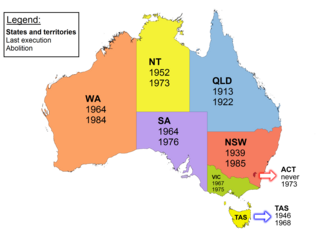
Capital punishment in Australia was a form of punishment in Australia that has been abolished in all jurisdictions. Queensland abolished the death penalty in 1922. Tasmania did the same in 1968. The Commonwealth abolished the death penalty in 1973, with application also in the Australian Capital Territory and the Northern Territory. Victoria did so in 1975, South Australia in 1976, and Western Australia in 1984. New South Wales abolished the death penalty for murder in 1955, and for all crimes in 1985. In 2010, the Commonwealth Parliament passed legislation prohibiting the re-establishment of capital punishment by any state or territory. Australian law prohibits the extradition or deportation of a prisoner to another jurisdiction if they could be sentenced to death for any crime.

On 11 December 1962, Ronald Turpin was one of the two last people to be executed in Canada. Turpin had been convicted of the murder of Metropolitan Toronto police officer Frederick Nash, 31. On 12 February 1962, Nash pulled Turpin over for a broken taillight while the latter was fleeing from a robbery. The two men got into a shootout, and Nash suffered a fatal gunshot wound to the abdomen. Turpin was hit twice, once in the arm and once in the face, giving him a scar on his left cheek.
Capital punishment has been abolished in the U.S. state of Maine since 1887.
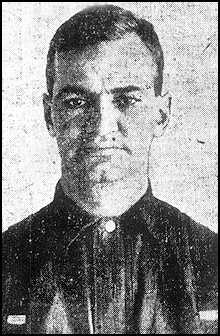
William Williams was a Cornish miner and the last person executed by the state of Minnesota in the United States. Williams was convicted for the 1905 murders of 16-year old John Keller and his mother, Mary Keller in Saint Paul, and his subsequent botched execution led to increased support for the abolition of capital punishment in Minnesota in 1911.

Christopher Chubasco Wilkins was a Texas spree killer who was sentenced to death and executed for a 2005 double murder.
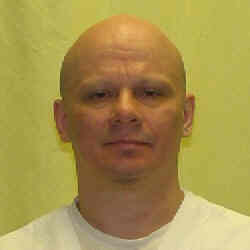
The execution of Robert Van Hook occurred on July 18, 2018, at the Southern Ohio Correctional Facility in Lucasville, Ohio. Van Hook was executed via lethal injection for the 1985 murder of 25-year-old David Self. His case achieved notoriety because of his failed gay panic defense. Ultimately, his conviction was upheld by the U.S. Supreme Court and Governor John Kasich of Ohio rejected his bids for clemency.

Daryl Linnie Mack was an American man who was executed in Nevada for murder. Mack was sentenced to death for the October 1988 rape and murder of Betty Jane May in Reno. The murder went unsolved for twelve years until DNA evidence linked him to the crime. He was already in jail at the time, having been sentenced to life in prison without parole for the April 1994 murder of Kim Parks. He was sentenced to death, waived his appeals and asked to be put to death. Mack was executed via lethal injection at Nevada State Prison on April 26, 2006. He remains the last person executed in Nevada.
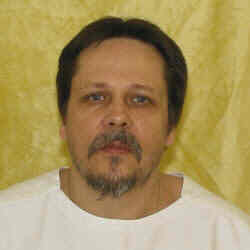
The execution of Dennis McGuire occurred on January 16, 2014, at the Southern Ohio Correctional Facility in Lucasville, Ohio, in what was considered to be a botched execution. McGuire was executed via lethal injection using a new combination of untried and untested drugs: midazolam and hydromorphone. During the execution, witnesses reported that McGuire could be seen struggling to breathe, and reportedly gasped loudly while making snorting and choking sounds for at least ten minutes. It took over twenty-five minutes for McGuire to die, in a process that should normally take just over eight minutes.














